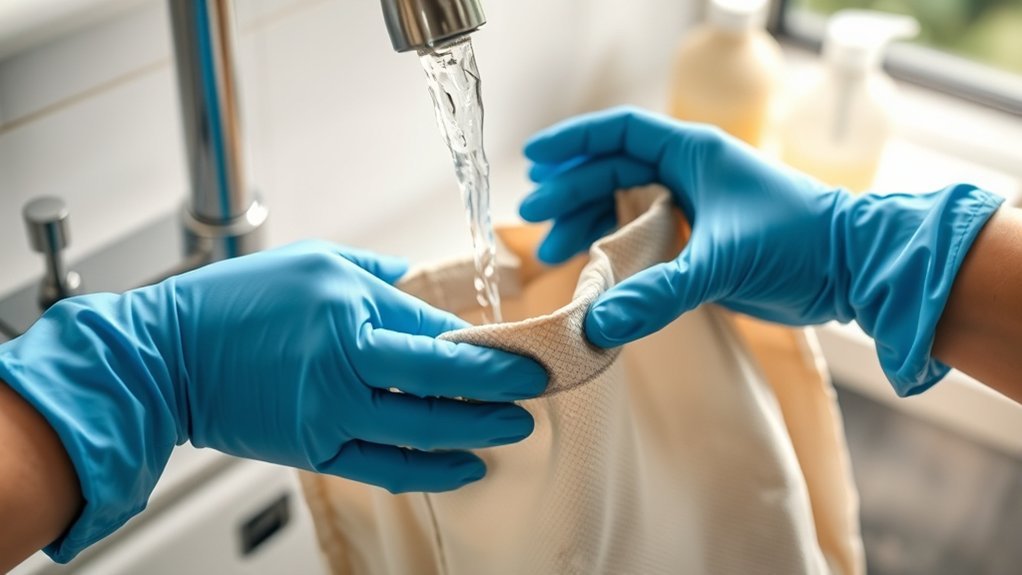Did you know that a clean carrier can greatly impact your pet’s health and comfort during travel? It’s not just about aesthetics; regular maintenance is essential to prevent the buildup of dirt and allergens. By implementing a few simple strategies, you can guarantee your pet’s carrier remains a safe space. Let’s explore practical tips that make washing carriers a straightforward task while keeping your furry friend’s travel environment pristine.
Understanding the Importance of Cleaning Carriers
While you may not think about it often, cleaning carriers is essential for maintaining the health and safety of your pets. Carrier hygiene directly impacts your furry companions’ well-being.
Over time, carriers can accumulate dirt, fur, and bacteria, creating an environment that poses health risks. These contaminants can lead to infections or allergic reactions, compromising your pet’s immune system.
Regularly washing your carriers not only removes these harmful substances but also guarantees a comfortable travel experience for your pets. By prioritizing carrier hygiene, you’re taking a proactive step toward safeguarding their health.
Regular Maintenance: Quick Cleaning Tips
To keep your pet’s carrier in top condition, you don’t need to dedicate hours to cleaning; instead, incorporate quick maintenance practices into your routine.
Start by wiping down surfaces with a damp cloth after each use to remove dirt and fur. For stubborn stains, a solution of mild soap and water works wonders—just make sure you rinse thoroughly.
Wipe down surfaces with a damp cloth after each use to keep your pet’s carrier clean and fresh.
Regularly check for any loose parts or wear and tear; addressing these issues early can prevent bigger problems later.
Don’t forget to clean the carrier’s floor mat or bedding weekly to guarantee a comfortable environment for your pet.
Deep Cleaning: When and How to Wash
Deep cleaning your pet’s carrier is crucial for maintaining a healthy environment, especially if your furry friend travels frequently.
Aim to perform this thorough cleaning every month or more often if your pet has been ill or the carrier shows signs of dirt or odor.
Utilize effective deep cleaning techniques such as disassembling the carrier, washing removable parts in warm soapy water, and using a pet-safe disinfectant for non-removable surfaces.
Rinse well and allow everything to dry completely before reassembling.
Pay close attention to corners and crevices where dirt can accumulate.
Choosing the Right Cleaning Products
When selecting cleaning products for your pet’s carrier, it’s essential to prioritize safety and effectiveness.
Consider using natural cleaners, as they’re often free from harsh chemicals that could harm your pet or the environment. Look for products that clearly state their ingredients and have been proven to effectively eliminate odors and stains without leaving harmful residues.
Pay attention to product effectiveness; read reviews to gauge how well the cleaner performs. Additionally, verify that the product is safe for various materials, especially if your carrier has fabric components.
Preventing Future Contamination: Best Practices
After choosing the right cleaning products, implementing best practices for preventing future contamination becomes crucial.
Start by identifying contamination sources in your environment, such as dust, spills, or unclean surfaces. Regularly review and update your sanitation routines to guarantee they effectively address these sources.
Establish a consistent cleaning schedule, focusing on high-touch areas and items prone to accumulation. Use designated cleaning tools and avoid cross-contamination by keeping them separate.
Encourage a culture of cleanliness among those around you, promoting awareness and responsibility. Additionally, maintain proper storage for cleaning supplies to prevent accidental spills.
Frequently Asked Questions
How Often Should I Wash My Carrier for Optimal Hygiene?
You should wash your carrier at least once a month for ideal hygiene. Frequent cleaning helps eliminate bacteria and allergens, ensuring a healthy environment for your pet. Regular hygiene practices promote their well-being and comfort.
Can I Use Bleach to Clean My Carrier?
You shouldn’t use bleach on your carrier, as it can damage certain materials. Instead, opt for bleach alternatives like vinegar or baking soda, ensuring a safe and effective clean without compromising the integrity of your carrier.
Are There Specific Cleaning Tools Recommended for Carriers?
You’ll want to use microfiber cloths, gentle brushes, and pet-safe cleaning materials for effective carrier maintenance. These tools help guarantee a thorough clean without damaging the carrier, keeping it safe and comfortable for your furry friend.
What Should I Do if My Carrier Smells Bad?
If your carrier smells bad, embrace natural deodorizing methods like baking soda or vinegar. These carrier odor solutions work wonders, liberating your space from unpleasant scents. Regular cleaning’s essential to keep odors at bay—don’t neglect it!
Is It Safe to Wash Carriers in a Washing Machine?
Yes, it’s safe to wash carriers in a washing machine, but choose appropriate machine settings based on fabric types. Always check care labels to avoid damage and guarantee thorough cleaning while preserving your carrier’s integrity.
Conclusion
In the journey of pet ownership, your carrier serves as a protective shell, much like a turtle’s home, sheltering your furry friend from the outside world. By committing to regular cleaning and maintenance, you guarantee that this sanctuary remains safe and welcoming. Embrace these prevention tips as your guiding compass, leading you toward a healthier travel experience for your pet. Remember, a clean carrier isn’t just a choice; it’s a promise of care and comfort for your beloved companion.
